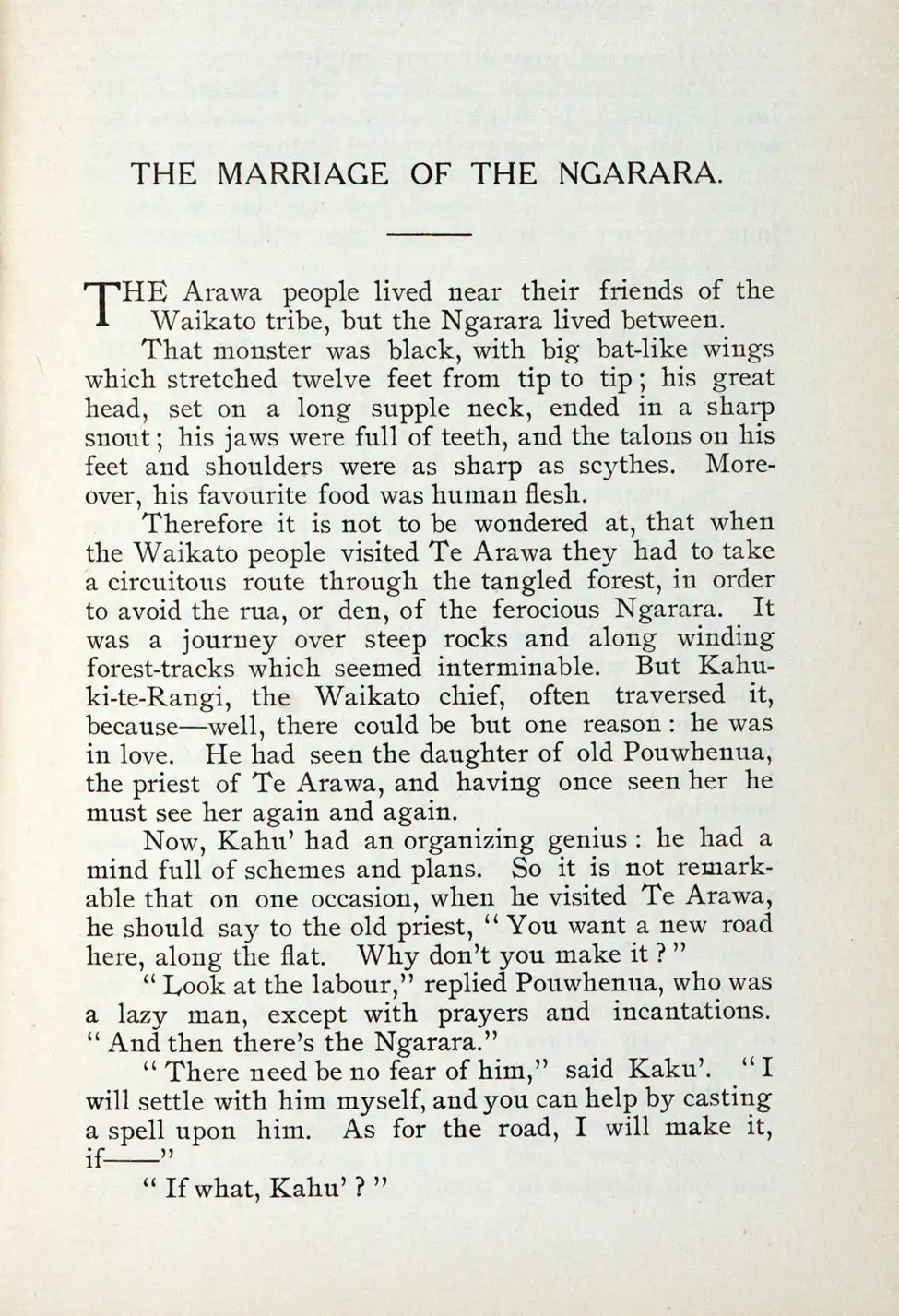Case 6
- Early Collectors and Publications, Grace and Smith

A.A. Grace. Folk-Tales of the Maori. Wellington: Gordon & Gotch, 1907.
Like Stephenson Percy Smith and Edward Tregear, the author Alfred Augustus Grace (1867–1942) believe the Māori were a race in decline. His Tales of a Dying Race (see case 13) was a great success so, spurred on by this and the interest in Māori culture, Grace published his Folk Tales of the Maori. The book is a collection of tales collected by Karepa Te Whetu of Ngāti Koata, and translated by Grace into what John O’Leary called ‘rather Edwardian idiom (at one point young Māori women are described as “gamboling like true daughters of their mother, Nature”, while a group of young Māori warriors is pictured as “as ardent a body of braves as ever owed fealty to a fair maid”)’ (O’Leary 118).
Folk Tales of the Maori was intended to be a serious contribution to ethnology, showing the blurred lines between science, history and mythology. ‘The Marriage of Ngarara’ shown here is one version of a tale in which a reptile (ngārara), which was associated with evil and death, is outwitted and destroyed.
John O’Leary. ‘Alfred Grace, 1867–1942’. Kōtare: New Zealand Notes & Queries, Special Issue. Essays in New Zealand Literary Biography Series Two: ‘Early Male Prose Writers’ 7.2 (2008): 117–122.
![S. Percy Smith. <i>The Lore of the Whare-wānanga; Teachings of the Maori College on Religion, Cosmogny, and History; Written Down by H. T. Whatahoro from the Teachings of Te Matorohanga and Nepia Pohuhu, Priests of the Whare-wānanga of the East Coast, New Zealand. </i> New Plymouth: Printed for the [Polynesian] Society by Thomas Avery, 1913. Two parts, part one displayed.](https://www.reedgallery.co.nz/__data/assets/image/0007/293416/Case-6b.webp)
S. Percy Smith. The Lore of the Whare-wānanga; Teachings of the Maori College on Religion, Cosmogny, and History; Written Down by H. T. Whatahoro from the Teachings of Te Matorohanga and Nepia Pohuhu, Priests of the Whare-wānanga of the East Coast, New Zealand. New Plymouth: Printed for the [Polynesian] Society by Thomas Avery, 1913. Two parts, part one displayed.
The Lore of the Whare-wānanga first appeared serially in The Journal of the Polynesian Society. The text was taken from manuscripts believed to have been transcriptions of teachings by priests at a school of learning in the 1860s made to preserve their knowledge. Some controversy around the manuscripts’ provenance exists, and scholars like M. P. K. Sorrenson note that Smith had ‘ridden rough-shod over Māori susceptibilities in publishing the material’ (Sorrenson 37).
The first volume is subtitled ‘Te Kauae Runga or Things Celestial’, and deals with the evolution of the world and the gods. It is open here to the tale of Tāne, god of the forest and birds and progenitor of humankind, who brought from the heavens three baskets (kete) of knowledge that were passed down to humanity.
M. P. K. Sorrenson. Manifest Duty: The Polynesian Society Over 100 Years. Auckland: The Polynesian Society, 1992.
![S. Percy Smith. <i>The Lore of the Whare-wānanga; Teachings of the Maori College on Religion, Cosmogny, and History; Written Down by H. T. Whatahoro from the Teachings of Te Matorohanga and Nepia Pohuhu, Priests of the Whare-wānanga of the East Coast, New Zealand. </i> New Plymouth: Printed for the [Polynesian] Society by Thomas Avery, 1913. Two parts, part one displayed.](https://www.reedgallery.co.nz/__data/assets/image/0007/293416/Case-6b.webp)
S. Percy Smith. The Lore of the Whare-wānanga; Teachings of the Maori College on Religion, Cosmogny, and History; Written Down by H. T. Whatahoro from the Teachings of Te Matorohanga and Nepia Pohuhu, Priests of the Whare-wānanga of the East Coast, New Zealand. New Plymouth: Printed for the [Polynesian] Society by Thomas Avery, 1913. Two parts, part one displayed.
Open image in new window

![S. Percy Smith. <i>The Lore of the Whare-wānanga; Teachings of the Maori College on Religion, Cosmogny, and History; Written Down by H. T. Whatahoro from the Teachings of Te Matorohanga and Nepia Pohuhu, Priests of the Whare-wānanga of the East Coast, New Zealand. </i> New Plymouth: Printed for the [Polynesian] Society by Thomas Avery, 1913. Two parts, part one displayed.](https://www.reedgallery.co.nz/__data/assets/image/0007/293416/Case-6b.webp)